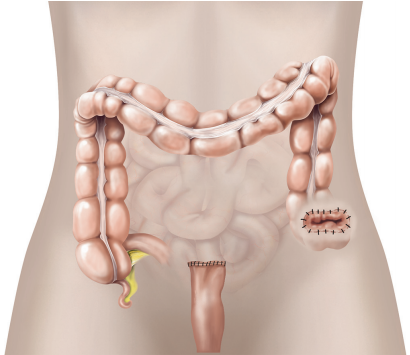What is Hartmanns procedure?
Hartmanns procedure involves removing a piece of large bowel (colon). It is usually performed as an emergency. The two ends of bowel were not joined together because your surgeon decided the risks were too high. Your surgeon made a colostomy (your large bowel opening onto your skin). The other end was closed as a rectal stump (see figure 1). Your surgeon has decided it is safe to join the two ends of your bowel back together.
What are the benefits of surgery?
You should be able to open your bowels in the normal way and you should no longer have a stoma bag.
What does the operation involve?
The operation is performed under a general anaesthetic and usually takes about 90 minutes to two hours. Your surgeon will make a cut through the scar from the first operation and a cut on your skin around the colostomy. Your surgeon will join the two ends of your bowel back together and place your bowel inside your abdominal cavity.
What complications can happen?
1. General complications
- Pain
- Bleeding
- Infection of the surgical site
- Chest infection
- Unsightly scarring
- Developing a hernia
- Blood clots
2. Specific complications
- Anastomotic leak
- Continued bowel paralysis
- Diarrhoea
- Death
How soon will I recover?
It is usual for your bowel to stop working for a few days. You should be able to go home after 7 to 10 days.
It can take up to three months to return to normal activities.
Regular exercise should help you to return to normal activities as soon as possible. Before you start exercising, ask the healthcare team or your GP for advice. Most people make a good recovery.
Summary
Reversal of Hartmanns procedure will allow you to open your bowels in the normal way. You will no longer need a stoma bag.
Acknowledgments
Author: Mr Jonathan Lund DM FRCS (Gen. Surg.), Illustrations: Medical Illustration Copyright © Medical-Artist.com
This document is intended for information purposes only and should not replace advice that your relevant health professional would give you.
